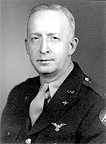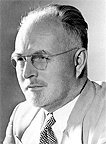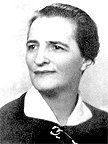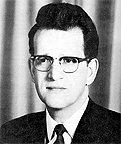Doctor #1: This photo, from the cover of the May 1934 issue of the National Chiropractic Association's (NCA) Chiropractic Journal shows the New York Yankees chiropractor-trainer (squatting left) treating a ballplayer as Babe Ruth (standing, center) looks on.
Doctor #2: This doctor, a graduate (BS) from Valparaiso University, earned his chiropractic degree from National College in 1922, and practiced in Hagerstown, Maryland. He was elected president of his state society, and served for many years on Maryland's Board of Chiropractic Examiners. The latter role involved him in the work of the Council of State Chiropractic Examining Boards (COSCEB; predecessor of today's FCLB). As president of COSCEB, he infuriated many chiropractic college leaders in the 1930s by introducing the first standards for accrediting the schools, and released the first list of colleges recognized by COSCEB. In this he preceded John Nugent,DC, future director of education for the NCA. A major in the Maryland division of the Civil Air Patrol during World War II, he and his wife died when their private plane crashed in rural Pennsylvania in 1950.
Doctor #3: This feisty 1912 alumnus of the PSC from Kansas was active in the first successful campaign to license the practice of chiropractic in his state. He became co-owner and for several decades was president of the then for-profit Texas Chiropractic College (TCC), and struggled to keep the school open during the lean years of the Great Depression (Keating & Davison, 1997; Rehm, 1980, pp. 286-7). A passionately "innate" chiropractor, he broadened his scope of practice as a consequence of the teachings of one of his alumni, Thurman Fleet,DC, of "Concept-Therapy" fame. As president of TCC, he joined with straight chiropractic college leaders such as Palmer, Cleveland, Ratledge and Kightlinger in opposing the early educational reform efforts of the NCA.
Doctor #4: This 1911 graduate of the Palmer School of Chiropractic (PSC) and cousin of Mabel Heath Palmer,DC. served as faculty member, registrar, business manager and vice president of his alma mater (Rehm, 1980, p. 285). A personal acquaintance of D.D. and B.J. Palmer, he attempted a family reconciliation at the PSC homecoming in 1913. As general manager of Radiophone station WOC in Davenport, Iowa, he helped to organize the National Association of Broadcasters (NAB) and was elected president of NAB in 1926. Elected repeatedly to the Iowa legislature, he is credited with obtaining the state's first chiropractic statute. He relocated to Denver in 1937, and practiced there for decades. At various times he served as a member of the board of directors and as president of the Colorado Chiropractic Association, and was a charter member of the ACA.
Doctor #5: This 1926 graduate of the Universal Chiropractic College in Pittsburgh practiced in Los Angeles for several years and served on the board of directors of the College of Chiropractic Physicians & Surgeons (Keating & Phillips, 2001). He collaborated with his father in teaching a new technique, and succeeded him as president of the chiropractic college established to further the new method. Aligning himself with B.J. Palmer and the ICA, he opposed the NCA's educational reform efforts in the late 1940s and 1950s, and was a co-founder of the North American Association of Chiropractic Schools & Colleges. It was expected that he would succeed B.J. as leader of the ICA, but he died unexpectedly in 1961, just a few months after the'"Developer's" demise.
Doctor #6: Born in Minnesota but raised in rural Saskatchewan, this second-generation chiropractor graduated from the PSC in 1926. He practiced all his life as a straight chiropractor, but valued continuing education in broad-scope chiropractic (Keating & Haldeman, 1995). In 1943 he served as Saskatchewan's representative in the formation of the Dominion Council of Canadian Chiropractors (forerunner of today's CCA), and was a co-founder of the Canadian Memorial Chiropractic College. He was leader of the Social Credit Party during World War II, and made an unsuccessful bid for the Canadian federal Parliament in 1945. He earned his private pilot's license in 1947, and drew international fame for his globetrotting adventures. In the early 1950s, he relocated his family to South Africa, where he pioneered his profession.
Doctor #7: This 1923 alumna of the Los Angeles College of Chiropractic (LACC) purchased the Pasadena Chiropractic College in 1948, from which she formed a "College of Chiropractic, Radio Therapy and Natural Healing." An enthusiast for radionics (derived from Albert Abrams, MD's vibrational theories), she marketed a "radio therapy instrument" that she purported could diagnose and treat disease remotely. As a consequence of this promotion, she was tried, convicted and fined $1,000 for violating the Food, Drug and Cosmetics Act in U.S. District Court in Los Angeles in 1951 (Keating & Phillips, 2001, pp. 117-8). Her school was purchased by another LACC graduate, Helen E. Sanders,DC, ND, and became the Hollywood College, School of Chiropractic & Naturopathy.
Doctor #8: The first and longest-serving (1930-1934) president of the NCA (predecessor of today's ACA), this 1915 PSC alumnus was a career-long opponent of B.J. Palmer. He served as president of the Kentucky Association of Chiropractors and as president of the International Congress of Chiropractic Examining Boards (forerunner of today's FCLB). It was in the latter capacity that he was instrumental in merging the formerly Palmer-controlled Universal Chiropractors' Association and an earlier ACA, to form the NCA in 1930. Descended from a chief justice of the Supreme Court and a vice president of the United States, he brought a dignity and an "organizational genius" (Rehm, 1980, pp. 294-5) to his professional work in chiropractic. In the 1930s he organized a state-funded investigation of the effects of chiropractic care on boys placed in reform school in Kentucky. In 1944 he was a co-founder of the Chiropractic Research Foundation, from which today's FCER evolved.
Doctor #9: He graduated from the St. Louis College of Chiropractic in 1918, and was co-founder of the Missouri Chiropractic College (MCC) in 1920, while completing his studies at the St. Louis College of Physicians & Surgeons (Rehm, 1980, p. 300). He never practiced medicine, and as president of MCC was a committed advocate of licensing for DCs in his native state. Active in the educational reform efforts of the NCA, he struggled to create a higher standard of training, despite the proprietary status of his school. Retiring in the early 1960s, he was succeeded as president by MCC alumnus Otto Reinert,DC, who supervised the school's merger with the Logan Basic College of Chiropractic in 1964. He passed away in 1974, at age 86.
Doctor #10: This 1942 alumnus of the PSC served as dean of the Atlantic States Chiropractic Institute (ASCI) in NYC, and later as president of the Columbia Institute of Chiropractic (CIC). He was elected to the ICA's Board of Control, but resigned and sought accreditation for the CIC from the ACA Council on Education in 1964 (Keating, et al., 1998). That same year, he oversaw the merger of the CIC and the ASCI. He later rejoined the ICA fold, and worked for federal accreditation of the Association of Chiropractic Colleges. In later years, he oversaw the reformation of CIC as the New York Chiropractic College and served as president of the CCE. He was president of the Association for the History of Chiropractic at the time of his death in 1985.
Answer Key: | |
1. | Erle Painter,DC |
2. | Wayne Crider,DC |
3. | James Drain,DC,PhC |
4. | Frank Elliott,DC,PhC |
5. | Vinton Logan,DC |
6. | Joshua Haldeman,DC |
7. | Ruth Drown,DC |
8. | Lillard Marshall,DC,FICC |
9. | Henry Harring,DC,MD,FICC |
| 10. | Ernest Napolitano,DC,LLB,PhC |
References
- Keating JC, Davison RD. That "down in Dixie" school: Texas Chiropractic College between the wars. Chiropractic History 1997 (June);17(1):17-35.
- Keating JC, Haldeman S. Joshua N. Haldeman,DC. The Canadian years, 1926-1950. Journal of the Canadian Chiropractic Association 1995 (Sept);39(3):172-86.
- Keating JC, Callender A, Cleveland CS. A history of chiropractic education in North America: report to the Council on Chiropractic Education. Davenport IA: Association for the History of Chiropractic, 1998.
- Keating JC, Phillips RB (Eds.): A history of Los Angeles College of Chiropractic. Whittier, CA: Southern California University of Health Sciences, 2001.
- Rehm WS. Who was who in chiropractic: a necrology. In Dzaman F, et al. (eds.) Who's Who in Chiropractic, International. Second Edition. Littleton CO: Who's Who in Chiropractic International Publishing Co., 1980.
Joseph Keating Jr.,PhD
Click here for previous articles by Joseph Keating Jr., PhD.















